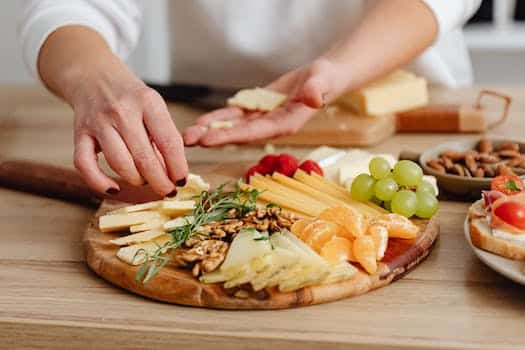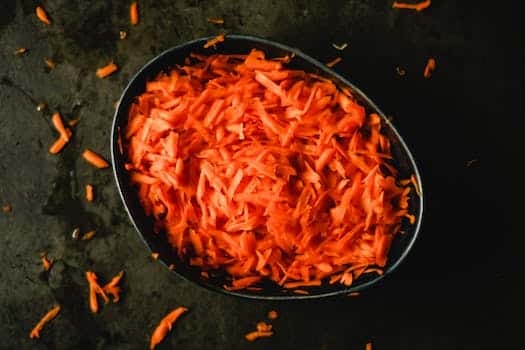In this comprehensive list, we will explore the top gluten-free foods and snacks available. Whether you follow a gluten-free diet due to celiac disease or personal preference, this article will provide you with a PDF guide to help you make informed choices. From gluten-free grains and flours to delicious snacks and treats, we’ve got you covered. Get ready to discover a variety of options that are both tasty and suitable for your gluten-free lifestyle.
- 1. Introduction
- 1.1. What is a gluten-free diet?
- 1.2. Benefits of a gluten-free diet
- 1.3. Challenges of following a gluten-free diet
- 1.4. Importance of having a list of gluten-free foods and snacks
- 2. Gluten-Free Foods
- 2.1. Fruits and vegetables
- 2.2. Meat and poultry
- 2.3. Fish and seafood
- 2.4. Dairy products
- 2.5. Grains and alternatives
- 3. Gluten-Free Snacks
- 3.1. Nuts and seeds
- 3.2. Rice cakes and popcorn
- 3.3. Gluten-free granola bars
- 3.4. Yogurt and smoothies
- 3.5. Vegetable chips and hummus
1. Introduction
Going gluten-free has become a popular dietary choice for many people, whether it is due to a gluten intolerance or simply a desire to live a healthier lifestyle. The market for gluten-free foods and snacks has grown significantly in recent years, offering a wide variety of options for those on a gluten-free diet. This comprehensive list of top gluten-free foods and snacks aims to provide a helpful resource for individuals seeking delicious and safe alternatives. From pantry staples to convenient on-the-go treats, this article will explore the best gluten-free options available in PDF format.
1.1. What is a gluten-free diet?
A gluten-free diet is a dietary approach that involves avoiding the consumption of gluten. Gluten is a type of protein found in grains such as wheat, barley, and rye. It is commonly found in many everyday foods like bread, pasta, and cereal. However, people with certain health conditions, such as celiac disease, non-celiac gluten sensitivity, or wheat allergy, may need to follow a gluten-free diet to manage their symptoms and promote overall well-being.
A gluten-free diet typically involves avoiding foods and ingredients that contain gluten. This includes obvious sources like wheat-based products, but also hidden sources like sauces, marinades, and processed foods. Many individuals on a gluten-free diet choose to substitute gluten-containing grains with alternative options like rice, corn, quinoa, and gluten-free oats.
It’s important to note that a gluten-free diet is not a weight loss or trendy diet plan. It is a necessary and medically prescribed diet for those with gluten-related disorders. Following a gluten-free diet can help alleviate symptoms such as digestive issues, fatigue, joint pain, and skin problems in individuals who are sensitive to gluten. It is always recommended to consult with a healthcare professional or registered dietitian before making any major dietary changes, especially if you suspect you have a gluten-related disorder.
1.2. Benefits of a gluten-free diet
A gluten-free diet has gained significant popularity in recent years, not only among individuals with gluten intolerance or celiac disease but also among those who are looking to improve their overall health. This diet involves eliminating gluten, which is a protein found in wheat, barley, and rye, from the daily food intake.
The benefits of following a gluten-free diet can be numerous. Firstly, for individuals with gluten intolerance or celiac disease, this diet is essential for managing their condition and preventing uncomfortable symptoms such as digestive issues, fatigue, and skin problems. By avoiding gluten, they can alleviate inflammation and promote gut healing.
Moreover, a gluten-free diet can also benefit individuals without gluten intolerance. Many people report feeling less bloated and experiencing improved digestion when they eliminate gluten from their meals. This is because gluten can be difficult to digest for some individuals, leading to discomfort and sluggishness.
Furthermore, a gluten-free diet can be a great way to explore and discover a variety of new and healthy foods. By cutting out gluten-containing grains like wheat, individuals are encouraged to try alternative grains such as quinoa, rice, and buckwheat. These grains are packed with nutrients and can add diversity to one’s diet.
In addition to the health benefits, a gluten-free diet has also become popular due to the increasing availability of gluten-free products and snacks. Many food companies now offer gluten-free versions of popular foods, making it easier for individuals to enjoy their favorite treats without compromising their dietary needs.
Overall, whether someone has gluten intolerance or simply wants to explore a healthier way of eating, a gluten-free diet can offer numerous benefits. From improved digestion to increased food variety, going gluten-free can be a positive lifestyle choice.
1.3. Challenges of following a gluten-free diet
Following a gluten-free diet can present several challenges for individuals. One of the major difficulties is the limited food options available. Gluten is a protein found in wheat, barley, and rye, which means that many staple foods such as bread, pasta, and cereal are off-limits. This restriction can make it challenging to find suitable alternatives that are both tasty and fulfilling.
Additionally, gluten can sometimes be hidden in unexpected places, making it necessary to carefully read labels and be aware of cross-contamination. For example, gluten can be found in sauces, condiments, and even in some medications. This constant need for vigilance can be overwhelming and time-consuming for those following a gluten-free diet.
Another challenge is eating out and socializing. Many restaurants and social gatherings may not offer gluten-free options or may not be knowledgeable about the potential risks of cross-contamination. This can make it difficult for individuals to enjoy meals outside of their own homes without the fear of accidentally consuming gluten.
Lastly, adhering to a gluten-free diet can be expensive. Gluten-free products are often more costly than their gluten-containing counterparts. This can put a financial strain on individuals and families who need to purchase specialized products regularly.
Despite these challenges, following a gluten-free diet is essential for individuals with gluten-related disorders such as celiac disease or gluten sensitivity. With careful planning, education, and support, it is possible to navigate these challenges and lead a healthy, gluten-free lifestyle.
1.4. Importance of having a list of gluten-free foods and snacks
Having a list of gluten-free foods and snacks is of utmost importance for individuals who follow a gluten-free diet. Gluten is a protein found in wheat, barley, and rye, and it can cause adverse reactions in people with celiac disease or gluten sensitivity. By having a comprehensive list of gluten-free foods and snacks, individuals can easily identify and choose products that are safe for consumption.
This article aims to provide a detailed PDF list of top gluten-free foods and snacks, offering a wide range of options for those who need to avoid gluten. Whether you are new to a gluten-free diet or are looking to expand your choices, this comprehensive list will be a valuable resource.
By having this list at your disposal, you can save time and effort in searching for gluten-free alternatives. It eliminates the need to scrutinize labels and ingredients every time you go grocery shopping or want to grab a quick snack. With a wide variety of gluten-free options available, you can enjoy delicious and nutritious meals without compromising your dietary needs.
Whether you are looking for gluten-free bread, pasta, snacks, or ingredients to cook with, this PDF list has got you covered. It includes popular brands and products that have been certified gluten-free, ensuring that you can trust their safety and quality.
In conclusion, having a comprehensive list of gluten-free foods and snacks is essential for individuals who follow a gluten-free diet. It provides convenience, peace of mind, and a diverse range of options. With this list, you can confidently navigate the world of gluten-free eating and continue to enjoy delicious meals and snacks without any worries.
2. Gluten-Free Foods
Gluten-free foods have gained popularity in recent years, not only among individuals with gluten intolerance or celiac disease but also among those who are looking for a healthier lifestyle. Whether you have a gluten sensitivity or just want to explore new food options, there is a wide range of gluten-free foods and snacks available.
1. Fruits and Vegetables: Naturally gluten-free, fruits and vegetables should be the foundation of any gluten-free diet. They are packed with essential nutrients and can be enjoyed in their raw form, cooked, or incorporated into various recipes.
2. Whole Grains: While many grains contain gluten, there are several gluten-free alternatives that can be included in your diet. These include quinoa, rice, corn, buckwheat, and amaranth. These grains provide fiber, vitamins, and minerals.
3. Legumes: Beans, lentils, and chickpeas are excellent sources of protein and fiber. They are versatile ingredients that can be used in salads, soups, stews, and even desserts.
4. Nuts and Seeds: Packed with healthy fats, vitamins, and minerals, nuts and seeds make for great gluten-free snacks. Almonds, walnuts, chia seeds, flaxseeds, and sunflower seeds are some popular choices.
5. Dairy Products: Most dairy products are gluten-free, including milk, cheese, yogurt, and butter. However, it’s important to check for any added ingredients or flavorings that may contain gluten.
6. Gluten-Free Grains and Flours: There are various grains and flours that are naturally gluten-free or specifically labeled as gluten-free. Some examples include gluten-free oats, almond flour, coconut flour, and tapioca flour.
7. Gluten-Free Breads and Pastas: If you’re craving bread or pasta, there are many gluten-free options available. Look for bread and pasta made from rice, corn, quinoa, or alternative flours.
8. Snack Bars and Granola: When you’re on-the-go or need a quick snack, gluten-free snack bars and granola can be a convenient option. Just be sure to read the labels and choose ones that are certified gluten-free.
Remember, when following a gluten-free diet, it’s crucial to read labels carefully, as gluten can hide in unexpected places. Additionally, consulting with a healthcare professional or registered dietitian can help ensure you’re meeting your nutritional needs while avoiding gluten.
2.1. Fruits and vegetables
Fruits and vegetables are a great choice for individuals following a gluten-free diet. Not only are they naturally gluten-free, but they also provide a wide range of essential nutrients. Fruits such as apples, bananas, oranges, and berries are excellent sources of vitamins, minerals, and antioxidants. They can be enjoyed as a healthy snack or incorporated into various dishes. Vegetables like spinach, broccoli, bell peppers, and carrots are packed with fiber, vitamins, and minerals, making them a nutritious addition to gluten-free meals. By including a variety of fruits and vegetables in your diet, you can ensure that you are getting the necessary nutrients while following a gluten-free lifestyle.
2.2. Meat and poultry
Meat and poultry are excellent options for individuals following a gluten-free diet. These protein-rich foods are naturally free from gluten, making them safe and suitable for those with celiac disease or gluten intolerance. Whether you prefer beef, chicken, turkey, or pork, there are numerous gluten-free recipes and dishes to explore.
When selecting meat and poultry products, it is important to read the labels carefully. Some processed meats, such as sausages or deli meats, may contain gluten as additives or fillers. To ensure gluten-free options, look for products that are labeled as ‘gluten-free’ or certified by a reliable gluten-free certification program.
Grilling, roasting, or simmering meat and poultry with gluten-free spices, herbs, and marinades can result in delicious and flavorful dishes. From juicy steaks and tender grilled chicken to savory meatballs and moist roasted turkey, the possibilities are endless. Additionally, incorporating lean cuts of meat and skinless poultry into your meals can add valuable nutrients like iron, zinc, and high-quality protein to your gluten-free diet.
To enjoy the benefits of meat and poultry while following a gluten-free lifestyle, it is essential to prioritize gluten-free cooking methods, ingredients, and sourcing. By doing so, you can savor a variety of tasty and nutritious dishes that meet your dietary needs.
2.3. Fish and seafood
Fish and seafood are excellent options for those following a gluten-free diet. They are naturally gluten-free and provide a plethora of health benefits. Fish, such as salmon, trout, and tuna, are rich in omega-3 fatty acids, which are essential for brain health and reducing inflammation. Seafood, including shrimp, lobster, and crab, are great sources of protein and contain important vitamins and minerals. Incorporating fish and seafood into your gluten-free meals can add variety and enhance the nutritional value of your diet. Whether grilled, baked, or sautéed, these delicious options are sure to satisfy your taste buds while keeping your gluten-free lifestyle on track.
2.4. Dairy products
Dairy products are a great option for those following a gluten-free diet. While some dairy products may contain small amounts of lactose, they are typically considered safe for individuals with gluten intolerance or celiac disease. Here are some gluten-free dairy products to include in your diet:
1. Milk: Regular cow’s milk is gluten-free, but it’s important to check for any added flavorings or additives that may contain gluten. Some individuals with gluten sensitivity may also choose to opt for dairy-free milk alternatives like almond milk or coconut milk.
2. Cheese: Most types of cheese, including cheddar, mozzarella, and Swiss, are gluten-free. However, it’s essential to read the labels carefully, as some processed cheeses or cheese spreads may contain gluten.
3. Yogurt: Plain yogurt is typically gluten-free, but flavored yogurts or those with added mix-ins may contain gluten. Always check the labels and opt for plain varieties to be safe.
4. Butter: Pure butter made from cow’s milk is gluten-free. However, some flavored or spreadable butters may contain gluten, so it’s crucial to read the labels.
5. Sour Cream: Sour cream is usually gluten-free, but it’s wise to double-check the ingredients list, as some brands may add thickeners or stabilizers that contain gluten.
Including these gluten-free dairy products in your diet can help you maintain a balanced and nutritious eating plan while avoiding gluten.
2.5. Grains and alternatives
Grains are an essential part of our diet, providing us with energy, fiber, and various nutrients. However, individuals with gluten intolerance or celiac disease need to avoid grains that contain gluten. Gluten is a protein found in wheat, barley, and rye, which can cause digestive issues and other health problems for those with sensitivities. Fortunately, there are several gluten-free alternatives available that can still provide the necessary nutrients and delicious options for individuals following a gluten-free diet.
One of the most popular gluten-free alternatives to traditional grains is quinoa. Quinoa is a versatile and nutritious grain-like seed that is naturally gluten-free and rich in protein, fiber, and essential minerals. It can be used as a base for salads, added to soups, or enjoyed as a side dish.
Another excellent gluten-free option is brown rice. Brown rice is a whole grain that retains its bran and germ, making it a nutritious choice. It is high in fiber, vitamins, and minerals, and can be used in various recipes, such as stir-fries, pilafs, or as a side dish.
Amaranth is a lesser-known gluten-free grain alternative that is worth exploring. It is highly nutritious, packed with protein, fiber, and micronutrients like iron and magnesium. Amaranth can be cooked as a porridge, added to stews, or used as a gluten-free flour substitute in baking.
For those who prefer a grain-free option, there are also alternatives available. Cauliflower rice has gained popularity as a low-carb and gluten-free substitute for rice. It can be easily made by grating or processing cauliflower into small rice-like grains and can be used in various dishes, including stir-fries, sushi rolls, or as a base for grain-free salads.
Other grain-free alternatives include almond flour, coconut flour, and chickpea flour. These flours can be used in baking to create gluten-free bread, cakes, and other baked goods. They provide a nutty flavor and a good source of healthy fats and proteins.
In conclusion, individuals following a gluten-free diet have a wide range of options when it comes to grains and alternatives. Quinoa, brown rice, amaranth, cauliflower rice, and various gluten-free flours can provide the necessary nutrients and diversity to create delicious gluten-free meals and snacks.
3. Gluten-Free Snacks
Gluten-Free Snacks
When it comes to gluten-free eating, finding tasty and convenient snacks can be a challenge. However, there are plenty of options available that are delicious and free from gluten. Here are some top gluten-free snacks to satisfy your cravings:
1. Fresh Fruit: Nature’s perfect snack, fresh fruits like apples, bananas, and berries are naturally gluten-free and packed with nutrients.
2. Nuts and Seeds: Almonds, walnuts, pumpkin seeds, and sunflower seeds are great options for a quick and healthy gluten-free snack.
3. Rice Cakes: Made from rice, these crispy snacks come in various flavors and can be topped with spreads or enjoyed plain.
4. Greek Yogurt: A creamy and protein-packed snack, Greek yogurt is a versatile option that can be enjoyed on its own or mixed with fruits and nuts.
5. Veggie Sticks with Hummus: Carrot sticks, cucumber slices, and bell pepper strips paired with gluten-free hummus make for a satisfying and nutritious snack.
6. Popcorn: A classic snack, popcorn can be a gluten-free option when prepared without any added flavors or seasonings.
7. Dark Chocolate: Indulge in a piece of dark chocolate to satisfy your sweet tooth. Look for brands that specifically mention being gluten-free.
8. Gluten-Free Granola Bars: Opt for gluten-free granola bars made with wholesome ingredients like oats, nuts, and dried fruits for a convenient on-the-go snack.
These gluten-free snacks provide a range of flavors and textures to keep your taste buds happy while adhering to a gluten-free diet. Experiment with different combinations and find your favorites!
3.1. Nuts and seeds
Nuts and seeds are excellent choices for gluten-free snacks. Not only are they naturally gluten-free, but they also provide a good source of protein, healthy fats, and essential nutrients. Nuts like almonds, walnuts, and cashews are packed with antioxidants, fiber, and omega-3 fatty acids, which are beneficial for heart health. Seeds such as chia seeds, flaxseeds, and pumpkin seeds are rich in essential minerals like magnesium, zinc, and iron. These snacks can be enjoyed on their own or added to other gluten-free foods like yogurt or salads for an extra crunch and nutritional boost. Incorporating nuts and seeds into your gluten-free diet is a tasty and nutritious way to satisfy your snack cravings.
3.2. Rice cakes and popcorn
Rice cakes and popcorn are excellent options for individuals following a gluten-free diet. These snacks provide a satisfying crunch and are versatile enough to be enjoyed on their own or paired with other ingredients. Rice cakes, made from puffed rice, offer a light and crispy texture that is both delicious and gluten-free. They can be topped with various spreads or used as a base for creating flavorful combinations. Popcorn, when prepared without any gluten-containing seasonings or additives, is a wholesome snack that is also gluten-free. It is a great source of fiber and antioxidants, making it a healthier alternative to traditional snack options. Whether you’re looking for a quick bite or a movie night treat, rice cakes and popcorn are sure to satisfy your snack cravings while adhering to a gluten-free lifestyle.
3.3. Gluten-free granola bars
Gluten-free granola bars are a delicious and convenient snack option for those following a gluten-free diet. Packed with wholesome ingredients, these bars provide a satisfying crunch while being free from gluten, a protein found in wheat, barley, and rye. Whether you have celiac disease or simply prefer to avoid gluten, these bars offer a tasty and nutritious on-the-go snack. Made with gluten-free oats, nuts, seeds, and dried fruits, they are a great source of fiber, protein, and healthy fats. Additionally, many gluten-free granola bars are also free from other common allergens, making them suitable for individuals with multiple dietary restrictions. Enjoy these scrumptious bars as a quick breakfast, a midday pick-me-up, or a pre-workout snack. With a wide variety of flavors and brands to choose from, gluten-free granola bars are a must-try for anyone seeking a delicious and convenient gluten-free snack option.
3.4. Yogurt and smoothies
Yogurt and smoothies are excellent options for those looking for gluten-free snacks. Not only are they delicious, but they also provide numerous health benefits. Yogurt is a rich source of probiotics, which promote a healthy gut and boost the immune system. It is important, however, to choose plain yogurt without any added flavors or sweeteners, as these might contain gluten. For a naturally sweetened option, you can add fresh fruits or a drizzle of honey to your yogurt. Smoothies, on the other hand, offer a refreshing and nutrient-packed snack. By blending together fruits, vegetables, and a dairy or plant-based milk, you can create a tasty and gluten-free treat. Be mindful of any toppings or mix-ins you add, as they may contain gluten. Overall, yogurt and smoothies are versatile snacks that can be enjoyed any time of the day while adhering to a gluten-free diet.
3.5. Vegetable chips and hummus
Vegetable chips and hummus are a delicious and healthy gluten-free snack option. Made from thinly sliced vegetables like zucchini, sweet potato, or kale, these chips are baked until crispy. They provide a satisfying crunch while being lower in calories and fat compared to traditional potato chips. Pairing vegetable chips with hummus adds a creamy and flavorful element to the snack. Hummus, made from chickpeas, olive oil, tahini, and various seasonings, is a great source of protein and fiber. It also contains heart-healthy fats that can help keep you feeling full and satisfied. Together, vegetable chips and hummus make for a nutritious and gluten-free snack that can be enjoyed any time of the day.
Conclusion
In conclusion, this comprehensive list of top gluten-free foods and snacks provides a valuable resource for individuals following a gluten-free diet. With a variety of options to choose from, individuals can enjoy delicious and satisfying gluten-free alternatives without compromising their dietary needs. From gluten-free breads and pastas to snacks and desserts, this list ensures that those with gluten intolerance or sensitivity can still indulge in tasty treats. Stay informed and explore the diverse range of gluten-free options available to maintain a healthy and enjoyable gluten-free lifestyle.






10 Comments
Adore Phalan
1 year agoThank you for sharing the link to the downloadable PDF featuring a comprehensive list of the best gluten-free foods and snacks. It is great to have such a resource that allows us to stay healthy while still enjoying delicious treats. I will definitely be downloading and exploring this valuable document.
Marlane Alvarez
1 year agoWow, this is exactly what Ive been looking for! As someone who follows a gluten-free diet, it can sometimes be challenging to find tasty snacks that are safe to enjoy. Having a comprehensive list of gluten-free foods and snacks in a downloadable PDF is such a convenient resource. I cant wait to explore all the delicious treats and stay healthy at the same time. Thank you for sharing!
Alanna Sherrie
1 year agoAs a normal human visitor, I find this post intriguing and scientifically informative. The mention of a comprehensive list of gluten-free foods and snacks in a downloadable PDF exhibits a practical approach to catering to individuals with gluten sensitivities or celiac disease. It is well-known that maintaining a gluten-free diet can be challenging, but this resource seems promising in terms of offering a wide range of delicious and healthy alternatives. I appreciate the emphasis on staying healthy while still being able to indulge in tasty treats. Thank you for providing this valuable resource!
Willie Duggan
1 year agoSounds awesome! Ive been looking for a good list of gluten-free foods and snacks. Cant wait to download the PDF and discover some delicious treats. Thanks for sharing!
Heloise Nathanson
1 year agoThank you for sharing this valuable resource! As someone who follows a gluten-free diet, it can often be challenging to find delicious and safe food options. Having a comprehensive list of gluten-free foods and snacks in a downloadable PDF format is extremely helpful. It not only saves time but also ensures that I can enjoy tasty treats without compromising my health. I appreciate the effort put into compiling this list and will definitely be downloading it. Heres to staying healthy and indulging in delightful gluten-free treats!
Rori Khalid
1 year agoWow, this is fantastic! Ive been trying to incorporate more gluten-free options into my diet, and having a comprehensive list of the best foods and snacks is just what I needed. Thank you so much for sharing this downloadable PDF. Now I can stay healthy while still indulging in delicious treats. Cant wait to explore all the options!
Darline Tarrant
1 year agoAs a normal human visitor, I would like to express my appreciation for the informative post on gluten-free foods and snacks. The provided downloadable PDF offers a comprehensive list of these products, which is great for individuals with gluten sensitivities or those following a gluten-free diet. It is commendable to see a focus on both health and indulgence, as it is important to enjoy delicious treats while ensuring our well-being. Thank you for providing such valuable information!
Ginger Christian
1 year agoWhoa, hold the gluten! This PDF is like a treasure map for my taste buds! I cant wait to dive into the world of gluten-free goodies and snack my way to a healthier and happier me. Time to say goodbye to boring old snacks and hello to a whole new level of deliciousness. Thank you, PDF, for showing me the way to gluten-free heaven!
Ashli Clarette
1 year agoWow, this PDF is like a gluten-free treasure map! Finally, I can navigate the snack aisle without feeling like a clueless pirate searching for that elusive gluten-free booty. Thank you for saving me from the land of bland and introducing me to a world of delicious treats. Time to treat my taste buds and keep my tummy happy, all while staying gluten-free like a boss! 🏴☠️🌈
Lesli Aramanta
1 year agoWow, a downloadable PDF for gluten-free foods and snacks? Now I can finally indulge in guilt-free treats without feeling like Ive joined a secret society! Who knew staying healthy could be this delicious? Cant wait to see what kind of magical gluten-free wonders await me in this mysterious PDF!